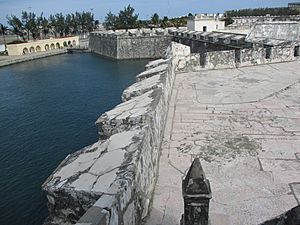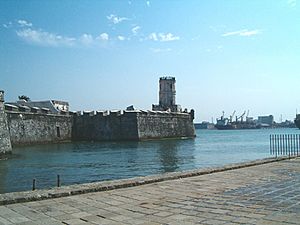San Juan de Ulúa facts for kids
Quick facts for kids Fortaleza de San Juan de Ulúa |
|
|---|---|
| Fortress of San Juan de Ulúa | |
| Veracruz, Veracruz, Mexico | |

View of the fortress
|
|
| Coordinates | 19°12′33″N 96°7′53″W / 19.20917°N 96.13139°W |
| Type | Fortress |
| Site information | |
| Controlled by | Instituto Nacional de Antropología e Historia |
| Open to the public |
Yes |
| Condition | Deteriorated |
| Site history | |
| Built | 1535 |
| Built by | Spanish Empire |
| Materials | Stone |
| Battles/wars | Spanish attempts to reconquer Mexico Mexican–American War French intervention in Mexico |
| Garrison information | |
| Past commanders |
Francisco Luján (1568) José Coppinger (1825) Mariano Arista (1838) Juan Morales (1847) |
San Juan de Ulúa, also known as the Castle of San Juan de Ulúa, is a huge group of fortresses, prisons, and a former palace. It sits on an island in the Gulf of Mexico, looking out over the seaport of Veracruz, Mexico.
The island was named in 1518 by an explorer named Juan de Grijalva. A year later, in 1519, Hernan Cortés met with important messengers from the Aztec Empire here. The fortress was built over many years, from 1535 to 1769. Today, it has a museum that opened in 1984.
Contents
History of the Fortress
The fort was first built when Spain ruled Mexico, starting in 1535. Spanish leaders kept making the fort bigger and stronger over time. For many years, it was a quiet Spanish army outpost in Mexico. In the 1580s, a designer named Battista Antonelli helped improve the fortress.
The fort didn't see much fighting during Mexico's war for independence. It was too far from the main battles.
A Famous Sea Battle
In 1568, Spanish soldiers at the fortress trapped a fleet of ships led by John Hawkins. His cousin, a young Francis Drake, was also there. Even though Hawkins and Drake managed to escape on their own ships, many other sailors were killed by Spanish cannons. Several ships were sunk or badly damaged.
The sailors who were left behind had no way to escape. They went inland and settled among the local people, becoming part of Mexican society. Hawkins and Drake continued to attack Spanish ships carrying valuable treasures like gold and silver from Spanish colonies. This battle at San Juan de Ulúa is said to have made Drake strongly dislike the Spanish, which affected his later life.
The Virgin of the Staircase
The fort once held a special statue called the La Virgen de La Escalera (Virgin of the Staircase). Her small chapel was under a stone staircase inside the fort. When ships arrived, this statue was lifted to the top tower to greet them. The ships would fire cannons to honor her.
This Virgin was well-known to travelers and people in Veracruz. The original statue disappeared hundreds of years ago after Mexico became independent. However, a very similar statue was brought to the Philippines a long time ago. Today, people in the town of Nasugbu in the Philippines still honor this statue every year on December 2nd. They have celebrations with prayers, parades, and blessings for farm animals.
After Spanish Rule
After Mexico became independent in 1821, some Spanish troops stayed at San Juan de Ulúa until 1825. It was the last place in Mexico that Spain still held. Mexican General Miguel Barragán took control of it in November 1825.
Since then, San Juan de Ulúa has been a symbol of Mexico's strength against foreign attacks. Many attacks happened in the 1800s:
- In 1838, the French attacked the fortress during the Pastry War. This war started because a French citizen wanted money for his damaged pastry shop in Mexico.
- During the Mexican–American War, the United States army surrounded the fortress.
- In 1863, the French briefly took over the city and tried to make Maximilian I the Emperor of Mexico.
For much of the 1800s, the fort was used as a prison. Many important Mexican politicians were held there when they were not in power.
The last foreign attack happened in 1914, just before World War I. American forces captured Veracruz, including San Juan de Ulúa, because of problems related to the Mexican Revolution and American oil interests. After some fighting, the Americans took the city. Seven months later, they left and gave the city back to Mexico. Veracruz was honored for its bravery in this event.
Parts of San Juan de Ulúa also served as a presidential palace for leaders like Benito Juárez and Venustiano Carranza. It was also a prison during the time of President Porfirio Díaz in the early 1900s.
San Juan de Ulúa Today
The fortress was eventually closed because it was no longer needed to defend Mexico. It was too old to be a modern naval base. After many years of falling apart, work began in the late 1900s to fix it up. Some of these repairs are still happening today.
San Juan de Ulúa has been saved and turned into a museum that is open to everyone. The old prison and most of the fortress are open to visitors. The former presidential palace is still being fixed up because it was very damaged. The complex is a very popular place for tourists in Mexico.
The fortress has even been in movies! San Juan de Ulúa was used to look like a fortress in Colombia in the 1984 film Romancing the Stone.
Images for kids
See also
 In Spanish: San Juan de Ulúa para niños
In Spanish: San Juan de Ulúa para niños















